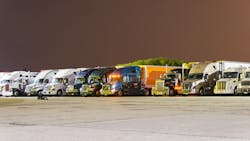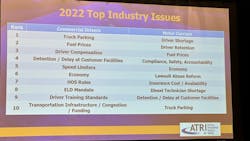Breaking down the disparities between carriers and drivers
DALLAS—“How do I deal with the driver shortage?” It’s a question carriers ask the American Transportation Research Institute a lot.
ATRI’s tongue-in-cheek response, according to Dan Murray, the institute’s senior vice president, is for motor carriers to stop looking at the top concerns on their own list and begin focusing more on the problems that drivers rate highest.
For the past 18 years, ATRI has been ranking the industry’s main concerns for both carriers and drivers in its Top Industry Issues Report. Every year, there are some pretty glaring disparities between the two groups that fleet owners and managers who are concerned about retaining drivers shouldn’t ignore.The driver shortage, for example, which has been ranked as the top concern for motor carriers six years in a row, isn’t a concern for drivers. Trucking parking, on the other hand, has historically ranked high among driver concerns, coming in as the top driver concern three years in a row, but only this year has made it onto the carriers’ top 10 list.
See also: Fuel prices, parking top trucking industry's biggest concerns
Federally mandating speed limiters is another example of an issue that has a different meaning for drivers than for carriers, Murray pointed out during Women In Trucking’s Accelerate Conference & Expo here.
“It’s not on the motor carrier list, why? The answer is slowly but surely, the motor carrier side has come around with the thinking that this probably isn’t bad,” Murray said of speed limiters. “They feel that if they are all [operating] at the same speed, there’s no competitive edge. The problem is there is very little empathy—not sympathy, but hands-on experience—on what the truck drivers are suffering from.”
But when you’re paid by the mile, speed limiters are problematic.
“The last thing you want to do is drive 55 mph because you might be making 75 cents a mile and you just knocked 10 miles off your hours,” Murray added. “So, this is going to be a real squeeze on driver compensation.”
The Federal Motor Carrier Safety Administration has revived its push for a controversial federal speed limiter mandate, sparking outrage among drivers and independent owner-operators. The draft of the FMCSA rulemaking, which has yet to propose a top speed limit for Classes 7 and 8 trucks, calls on speeds to be governed through trucks’ electronic engine control units.
In September, FMCSA announced its intention to proceed with a speed limiter rulemaking and is preparing a supplemental notice of proposed rulemaking projected for publication on June 30, 2023. It’s also something FMCSA’s administrator Robin Hutcheson alluded to during her Women In Trucking conference keynote on Nov. 13 when discussing the administration’s National Roadway Safety Strategy and push for zero fatalities.“For the first time, the Department of Transportation has declared that zero is the right number of fatalities on our nation’s highways,” Hutcheson told WIT’s 1,700-plus conference attendees. “We believe that we are going to lead the way to zero fatalities on our nation’s highways. There are about 5,000 fatal crashes involving a commercial motor vehicle—800 of those fatalities are drivers.”
She further emphasized the need to create a redundant safety system that accounts for human error. “That means we need safer roads, safer vehicles, safer people, and safer speeds,” Hutcheson noted.
The far-reaching impact of high fuel prices
One similarity for both carriers and drivers, according to ATRI’s top issues list this year, is their concern about record-high fuel prices (the No. 1 concern for carriers and No. 2 for drivers).
“What’s important about this list is things ebb and flow,” Murray said. “It’s not surprising that fuel prices is just one step higher for motor carriers because fuel prices are really bad.”
“I promise you it’s on the top industry issues list for a very short term,” he added. “It’s an acute issue. The minute it goes down, it drops off the list.”
However, Murray was quick to note his concern about the impact high fuel prices is having on owner-operators and smaller trucking companies long term.
See also: Smaller carriers face more risk as fuel prices resume rise
“Owner-operators do not get buying power; they pay through the nose for fuel, and they don’t get the economies of scale,” Murray said. “So, I am very nervous about owner-operators and small fleets right now if this economy continues to soften.”
On the other hand, larger truckload carriers are doing well in this soft economy and moving contract loads at near 95% capacity, he added, noting many of the smaller carriers and owner-operators were playing the spot market for two years before it cooled off recently.
That stabilization of the spot market, he noted, has opened more opportunity for acquisitions across the industry.
“There are so many acquisitions and so many more acquisitions coming,” Murray said. “Acquisitions will be a way of the world for another year or two. When spot markets get back up, it might be a little harder to buy these companies.”
Truck parking: Carriers, drivers share common ground
For the first time this year, truck driver parking made the list of top carrier concerns. Inadequate truck parking hurts drivers and, in turn, carriers, when it comes to compensation, revenue, safety, and compliance.
“This is so problematic because drivers are losing about $5,000 a year, leaving revenue routes, to look for truck parking,” Murray said. “If they’re lucky they’ll find something around 4 or 5 p.m. In the old days, they didn’t have to look for truck parking until 7 p.m. Now, if they don’t find anything after 5 p.m. they will have to start parking illegally.”
During her speech to WIT Accelerate attendees, Hutcheson emphasized the administration’s priority to tackle this problem.
“If we want to address safety, economic strength, equity, we have to address truck parking in the United States,” Hutcheson said. “Secretary Buttigieg has deemed this as a Department of Transportation priority. A tired driver is not safe. A driver that feels like they are parking in an unsafe place because they are on an offramp, not in a well-lit place, or at a place that doesn’t have the right facilities—that’s an area for improvement.”
See also: DOT leader touts safety, making trucking a better place to work for drivers
Hutcheson pointed to recent grants and initiatives to expand truck parking in Florida and Tennessee.
“You might be thinking that’s just two states, but it is an example of what can be done when you put your resources on it,” Hutcheson said. “We are going to lead by example. We have every single division of the [FMCSA] to use that guideline to expand truck parking in every state.”
Murray pointed out that although FMCSA is trying to find the money needed for more grants and initiatives to solve the truck parking crisis, FMCSA’s funds for truck parking projects are relatively small compared to the discretionary funds that the Federal Highway Administration can find to mitigate the problem.
“If you’re in insurance, if you’re a defense attorney, and if you’re a truck driver, this is a bad situation,” Murray said. “That’s why it’s No. 1 three years in a row for truck drivers, and that’s why they discovered on the motor carrier side that they should care about this more.
“More than a third of drivers are parking in an unauthorized location three to four times per week,” he added. “It’s a borderline catastrophe, but the good news is it looks like Congress is going to do something about it.”
About the Author

Cristina Commendatore
Cristina Commendatore is a past FleetOwner editor-in-chief. She wrote for the publication from 2015 to 2023.


